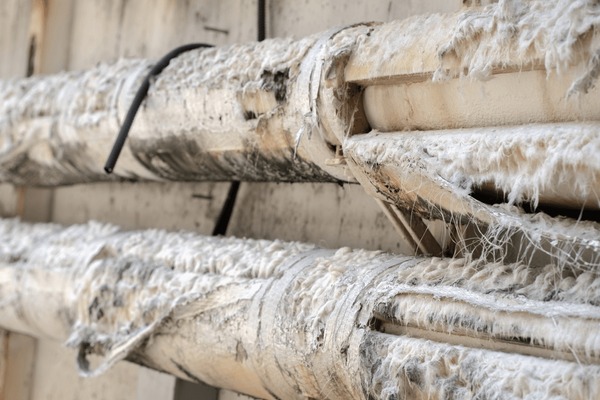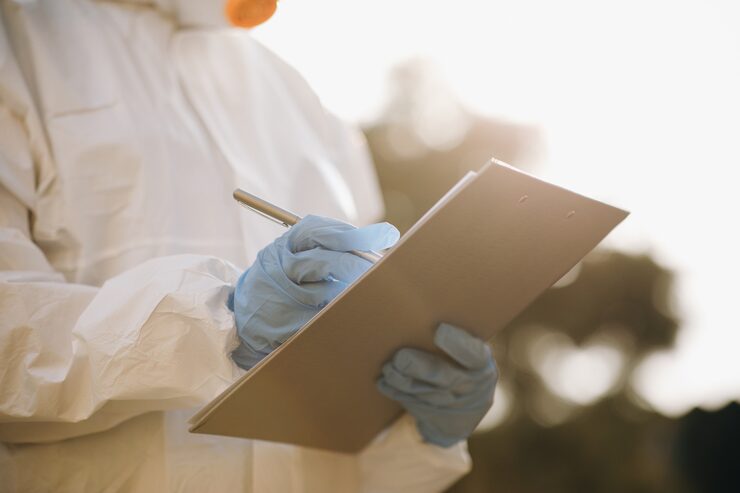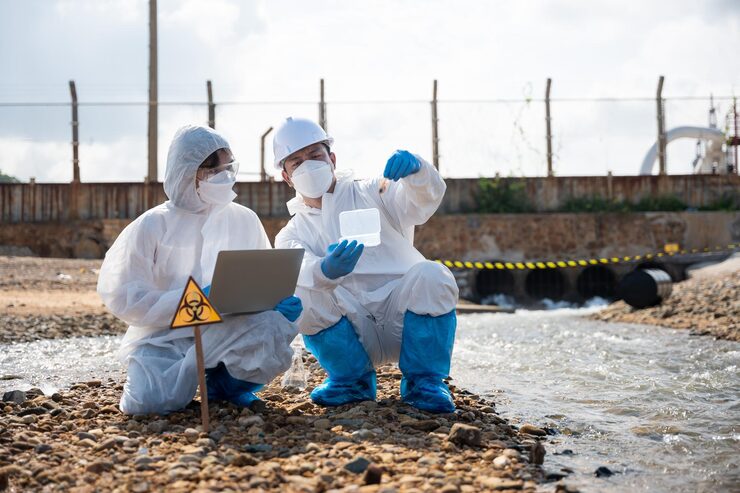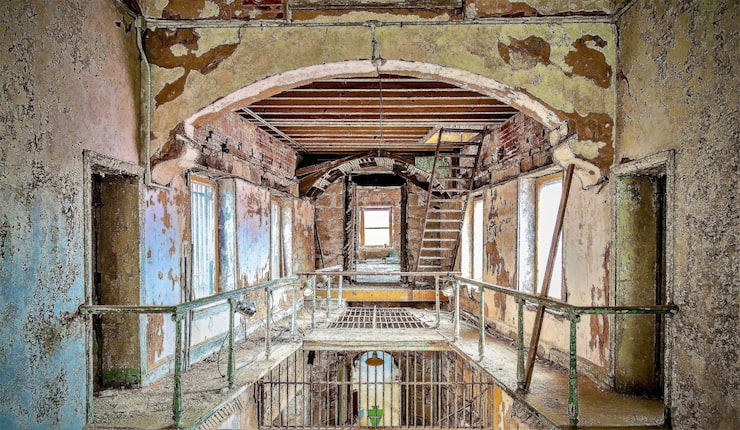Australia was one of the largest producers and consumers of asbestos between 1880 and 1985, the business reaching its peak between 1930 and 1980. Owing to this, multiple older properties, both residential and commercial, constructed prior to the 1990s, contain asbestos in the insulation materials. This makes detection tricky; asbestos insulation is hidden from plain sight and hence not easily noticeable.
Let’s learn more about asbestos insulation, where it is found, and the steps to take in case you come across it.
What is Asbestos Insulation?
Asbestos is a naturally occurring heat and corrosion-resistant fibrous mineral, traditionally used in wall boards and cladding as a fireproofing and insulating material. Asbestos Insulation is a material that contains asbestos and aims to provide this insulating property.
In the 1900s, asbestos became a popular insulating material due to the following properties:
- Ability to withstand fire and high temperatures.
- It is an excellent electrical insulator.
- The long, thin fibres can be woven for durability and made into different materials.
- The material was fairly inexpensive and easily available.
However, due to its adverse effects on human health, it was phased out in Australia post-1980 and finally banned in 2003.
What are the Most Common Forms of Asbestos Insulation
In Australia, the types of asbestos insulation commonly available include:
Loose-fill asbestos Insulation
Extremely hazardous and easily airborne, these are available as fluffy, loose, and highly friable materials. Earlier, these were blown into the cavity walls, attics, and loft spaces to provide insulation. These contain a higher percentage of asbestos by weight and are extremely hazardous to human health since they are easily airborne and can be inhaled.
Asbestos Pipe Insulation (Lagging)
Often found in industrial and older residential heating systems, these were designed as preshaped tubes and felt wraps that went around HVAC ducts, hot water pipes, gaskets, and valve covers. As they age, they can become airborne, especially if repairs are conducted without proper precautions and procedure.
Sprayed-on Insulation
These are applied to walls, ceilings, and beams for fireproofing, and have a fine yet uneven texture from being sprayed onto the surfaces. They are also common as asbestos roof insulation. Mostly found in commercial and industrial installations, this is highly friable and poses significant hazards to human health.
Vermiculite Insulation
These pebble-like granules were used as insulation in attics in residential houses. These are often contaminated with amphibole asbestos, and airborne fibres can be released at any time they are disturbed.
Block or Board Insulation (Asbestos Millboard)
These are large, solid slabs of asbestos that are fixed to the walls, floors, and ceilings of older houses and industrial complexes. These pose a risk of exposure due to ageing, and when the area is drilled, cut, or otherwise damaged.
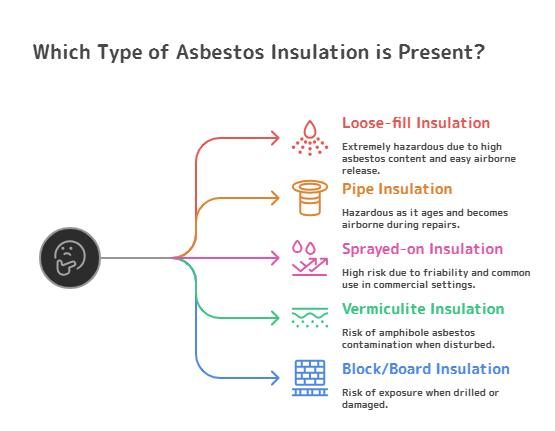
Where are Asbestos Insulations Commonly Found
The three main installations where asbestos insulations are found include:
- Residential Homes: Ceilings, attics, around hot water systems, and wall cavities.
- Schools: Pipe lagging, ceiling tiles, and boiler rooms.
- Commercial and Industrial: Sprayed coatings on beams, ductwork insulation, HVAC systems, and machinery.
Thus, no matter the type of building, the highest chances of finding asbestos insulation are
- In and around the HVAC ducts,
- Hot water pipes from the boiler,
- Cavities of the wall and ceilings, and
- Insulating boards around walls.
At a Glance: Common Forms of Asbestos Insulation and the Risks They Pose
To get a concise and accurate idea of the types of asbestos insulation and the threats they pose, we can also look at the following table:
| Type | Description | Where They are Found | Risk Level | Notes |
| Loose Fill | Fluffy and easily disturbed | Attics, cavity walls | Very High | Extremely friable, fibres easily released into the air and spread throughout the home. |
| Pipe/Duct Wrap | Felt, wool, or preformed wrap | Around pipes, ducts, and boilers | High | Crumbles and flakes over time, releasing fibres during maintenance or deterioration. |
| Spray on | Applied for fireproofing and soundproofing | Ceiling beams, walls, furnaces, and boilers | Very High | Friable; fibres can be released with vibration, drilling, or natural wear. |
| Vermiculite | Pebbly and granular | Attic | High | Can shed fibres with age. |
| Block/ Wool Board | Rigid blocks of wool boards | Wall insulation | Moderate | Less friable but dangerous when cut, broken, or deteriorated. |
Table: Different Forms of Asbestos Insulation
Which Health Risks are Associated With Asbestos Exposure
When cut, drilled, broken, water-blasted, or damaged, asbestos releases small fibres which can be inhaled. In the human system, these can damage the lung tissue and cause scarring.
The medical issues that can be caused by asbestos exposure are:
- Asbestosis
- Lung cancer and mesothelioma
- Scarring of the lung tissue
- Heart disease
- Respiratory failure
- Difficulty in swallowing
- Colon, ovarian, and digestive tract cancer
Further, the signs of asbestos poisoning can present as follows:
- Shortness of breath
- A persistent dry cough
- Chest pain and tightness
- Dry and crackling sounds when inhaling
- Clubbing of fingertips and toes (wide and round appearance)
Thus, it is important to leave asbestos undisturbed during renovation or undergo appropriate remediation.
How to Identify Asbestos in Insulation Materials
To learn if the insulating material in question contains asbestos, you can look at the following signs:
- A product that is fluffy, fibrous, and crumbly in texture.
- Inspect pipe wraps, cladding, vermiculite, and boards.
- Look at signs of fraying, dust, and powdery residue in damaged insulating materials.
Further, the age of a building also sheds light on whether or not it can potentially contain asbestos. To learn this, you may take a look at the property records.
To verify the presence of asbestos, you can opt for the following lab tests:
- Bulk sampling of material collected from the site.
- Polarised Light Microscopy (PLM) to identify asbestos fibres.
- Transmission Electron Microscopy (TEM) for accurate identification of smaller fibres.
- On-site detection devices like infrared and X-ray fluorescence analysers can also be used.
Steps to Follow If the Presence of Asbestos is Suspected
In case you feel your residence or office has asbestos in the insulating materials, the following steps are to be followed:
- Immediately cease construction, renovation, or maintenance work to prevent a disturbance.
- Do not try to touch, drill, sand, or remove the suspected material.
- Seal off the area that has asbestos with tape and plastic sheeting.
- Post warning signs to inform others of the potential hazard.
- If asbestos is found in the workplace, inform the authorities.
- In case the asbestos is present at your residence, contact the property owner, landlord, or a remediation agency.
- Hire a licensed asbestos specialist or remediation expert.
- These people will test for asbestos at the site and check the damage.
- Then they will remove and dispose of the material by following a safe disposal procedure.
- Further, they will also provide an asbestos plan as well as remediation records for the future.
How to Prevent Asbestos Exposure
To prevent an incident where you, your workforce, or your family gets exposed to asbestos, follow the tips below:
- Avoid disturbing the asbestos insulation.
- Make sure to use PPE like gloves, goggles, and N95 / P100 masks.
- Only licensed or trained personnel should handle the asbestos.
- To suppress dust and airborne fibres, use wet methods.
- Seal the disposed waste securely to prevent exposure.
- Restrict access to areas that contain asbestos.
- At workplaces, train the personnel to respond to asbestos contamination and exposure.
Wrapping Up
Asbestos insulation is common in older Australian properties. Thus, it is important to know the types, locations, and risks to help homeowners, schools, and businesses act safely. For disposal and remediation, always involve professionals who are certified for the same.
Addressing the Presence of Asbestos Insulations
Concerned about asbestos insulation in your property? Book a professional asbestos inspection today to protect your family, staff, and community.


